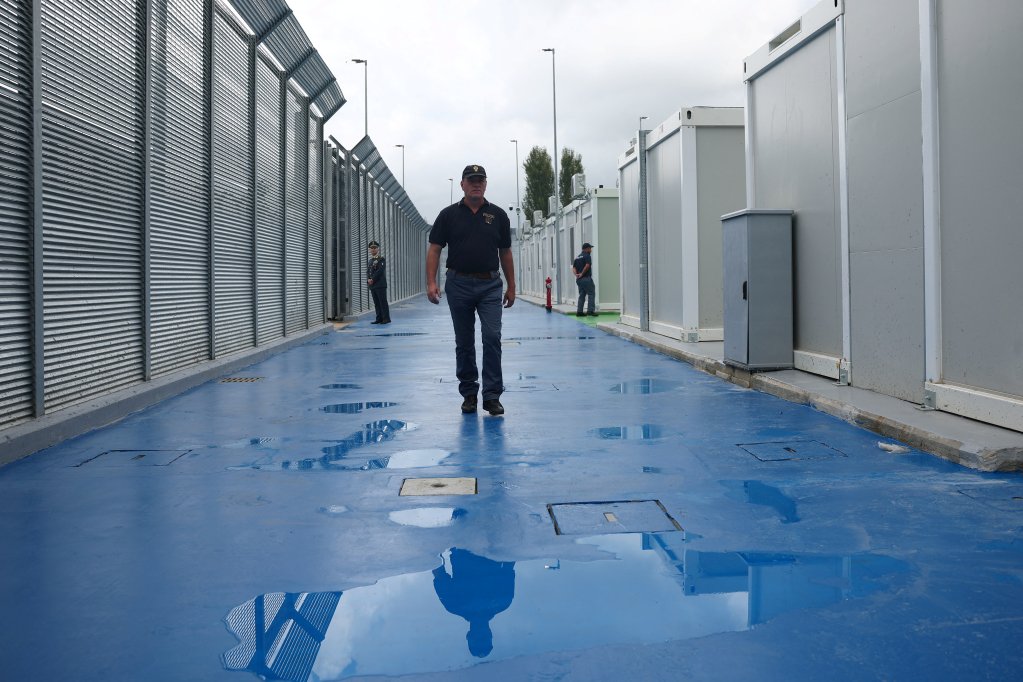Report finds Italy’s migrant centers in Albania are ‘costly and inefficient’

Rome: A report by the human rights organization Action Aid and the University of Bari in southern Italy has found that Italy’s migrant processing centers in Albania are costly and inefficient.
Italy’s migration processing centers in Albania are the “most costly” of all the repatriation and detention centers (CPRs) that Italy operates, declares a new report from the human rights organization Action Aid, in collaboration with the University of Bari in southern Italy.
The report authors obtained data from all 14 active CPRs in Italy and Albania, and found that the centers in Albania were “the most costly, inhumane and inefficient in the history of Italian migration policy.”
According to the report, the costs of the CPR in Albania amounted to “114,000 euros per day for only five days of activity in 2024.”
The report states that the Rome Prefecture paid 570,000 euros to the company Medihospes which is running the CPR in Albania for five days of actual operational activity.
That means it costs 114,000 per day to detain 20 people between October and December 2024. All the detainees were freed and sent back to Italy within a few hours or days of arrival.
File photo: Italy’s Prime Minister, Giorgia Meloni, as she meets Albania’s Prime Minister, Edi Rama, at Chigi Palace, in Rome, Italy, 6 November 2023 and signs up to build the Albanian centers | Photo: Giuseppe Lami / ANSA
File photo: Italy’s Prime Minister, Giorgia Meloni, as she meets Albania’s Prime Minister, Edi Rama, at Chigi Palace, in Rome, Italy, 6 November 2023 and signs up to build the Albanian centers | Photo: Giuseppe Lami / ANSA
However, Italy’s Prime Minister Giorgia Meloni has repeatedly hailed the Albanian centers as central to her tough migration policy, and several other European countries have visited Italy to examine ways to begin something similar for their countries.
EU Ministers are also seriously discussing how to build return hubs in third countries, as part of the new pact on Asylum and Migration, to be rolled out across the EU next year.
Overall, the report looked at the costs of the Albania center up until March 2025, before it began operating as a repatriation center for those already issued with notices to quit Italy.
According to Action Aid and UniBari’s report, by the end of March 2025, the Italian center in the Albanian city of Gjader had a capacity of 400 places. 74.2 million euros was paid out in contracts for the construction of that center and the smaller processing center at the port of Shengjin. According to the report’s authors, this means that the Italian government paid more than 153,000 euros to create one place at the center.
The costs of creating the same kinds of detention and repatriation centers in Italy are “starkly different,” comments Action Aid in a press release from July 24. In 2024, a center built in Porto Empedocle cost one million euros to create 50 effective places, that is roughly 21,000 euros per place.
At the end of 2024, there were 11 CPRs operating in Italy, with around 1,522 places overall. In addition, there are around 1,033 places in three other forms of detention centers (Ctra), which would bring the total number of places available to 2,555. Two of those new Ctra centers were built in Sicily (Modica, Ragusa and Porto Empedocle, Agrigento) and the third was the transformation of the processing center in Gjader, Albania, the report states.
However, reportedly due to delays in renovations, as well as “continual damage” to the structures themselves, the system functions at about 46 percent capacity. Fabrizio Coresi, a migration expert at Action Aid, commented that “the attempt to use the CPR in Gjader to try and detain irregular migrants present in Italy appears to be an irrational and illogical decision.”
One of the Italian government’s justifications for creating CPRs is that they make the returns system “more efficient.” However, the report’s authors argue that, in practice, “detaining people just ends up putting up the economic and human costs of repatriation.”
According to ActionAid, the legal complexities of carrying out actual repatriations have led to average detention periods of around 18 months since September 2023.
The year 2024, according to the report, marked a “historic low” for Italy regarding the number of people actually deported. Ten years earlier, in 2014, fewer than half of all those who entered a detention center to be deported were actually returned, wrote the report’s authors. By 2024, Italy’s CPRs only managed to deport 10.4 percent of all who entered a CPR.
Interestingly, in 2024, almost 45 percent of people detained in a CPR in Italy were actually trying to seek asylum. 21 percent of those detained, notes the report, hadn’t yet received a notice to quit the country.
Giuseppe Campesi from the University of Bari commented that “the use of detention as an instrument of asylum policy signals an epochal change, which raises serious questions about whether or not the use of such an instrument threatens the human rights of the persons to which it is applied.”
Campesi said that some of these “serious questions” were already being raised through Italy’s judicial process, whereby judges have ruled to suspend detention orders or have referred the new policies applied by Meloni’s government to higher courts in Europe.
Following judicial processes, the number of people who were detained and then ordered to be freed by judges has risen from a rate of 9 percent in 2021 to 29 percent in 2024, noted Campesi.
In the last two years, a total of 186 people were detained despite having a right to reception in Italy, and were then released, which was in fact 89 percent of the 208 asylum seekers who were detained initially in a new Ctra.





